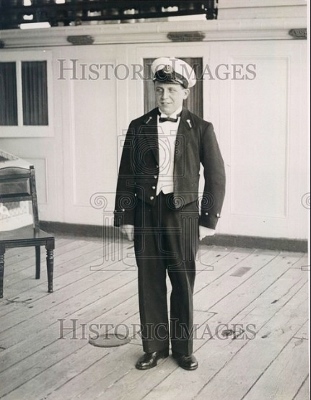Wreath for drowned Thame Naval Officer delivered from Cunard liner
On 29/10/2016 At 2:00 am
Category : Missed a ThameNews story?, More News, Thame news
Responses : No Comments
OF all the visits to the War graves of Thame Servicemen made as part of the Thame Remembers project, the most extraordinary must be that made to the middle of the Atlantic Ocean in a Cunard liner, to the wreck of a captured French torpedo boat.
With the help of the National Hydrographic Office in identifying the exact location of the wreck, and the co-operation of Cunard, Thame resident, Wendy Townsend, was able to drop a Thame Remembers wreath over the side of the ocean liner, Queen Mary 2, at the almost exact spot where the boat went down, and with it an English Lieutenant Commander, Hugh McRae.
The incredible story of how Wendy and the Thame Remembers team were able to overcome the logistical challenge of such a feat, is told in the latest Thame Remembers Newsletter shortly to be published.
So who was Lieutenant Commander, Hugh McRae and how did he happen to be in command of a French Torpedo boat? The following extract from the newsletter explains:
“Hugh, born in 1909 and educated at Lord Williams’s Grammar School in Thame, joined the Navy as an officer cadet in 1926, and served on a number of ships before being posted to the destroyer HMS Grafton as second in command in 1938. In June 1940, during the evacuation from Dunkirk and after successfully rescuing 1600 troops, the Grafton was struck by a torpedo from U-62 and her captain and fourteen others were killed. Lt McRae was rescued, was subsequently Mentioned in Despatches, and was promoted to Lieut-Commander, taking over command of the captured French torpedo boat Branlebas.
“Branlebas was one of the units of the French Navy which adhered to General de Gaulle´s Free French force after the capitulation in June 1940. The vessel was manned by a mixed French and British crew and came under the orders of the British Navy. On December 13, 1940, she left Dartmouth at around 18:00 hours and was charged with escorting a west-bound convoy, but her poor sea-going qualities meant she could not keep pace in rough weather and she lost contact. At 09:00 on the 14th, a heavy sea caused her to break her back at the aft end of the engine room, separating the stern section; she turned over and sank immediately. There were only three survivors, picked up from a life raft four days later, from a complement of 92. Hugh McRae was not among them.”
Branlebas’ s wreck now lies at a depth of 68 metres, approximately three miles due south of Lizard Point, and is a protected ocean grave.
 Wendy talks about the whole experience in the newsletter article, describing the dropping of the wreath as: “…very moving in the dark of the night with the waves rushing by.” She concludes: “The Deputy Captain (Karl Shepherd from Witney) and I tipped the wreath over into the sea. It all happened so quickly in the end that there was no chance of the actual wreath- laying to be photographed, only our backs as we looked over to follow its progress, but it disappeared very rapidly in the waves. We all felt that it was a very emotional and moving experience and I was honoured to be able to take a small part.”
Wendy talks about the whole experience in the newsletter article, describing the dropping of the wreath as: “…very moving in the dark of the night with the waves rushing by.” She concludes: “The Deputy Captain (Karl Shepherd from Witney) and I tipped the wreath over into the sea. It all happened so quickly in the end that there was no chance of the actual wreath- laying to be photographed, only our backs as we looked over to follow its progress, but it disappeared very rapidly in the waves. We all felt that it was a very emotional and moving experience and I was honoured to be able to take a small part.”
To find out more about the Thame Remembers Project, visit the website: http://www.thameremembers.org/about-the-project/


